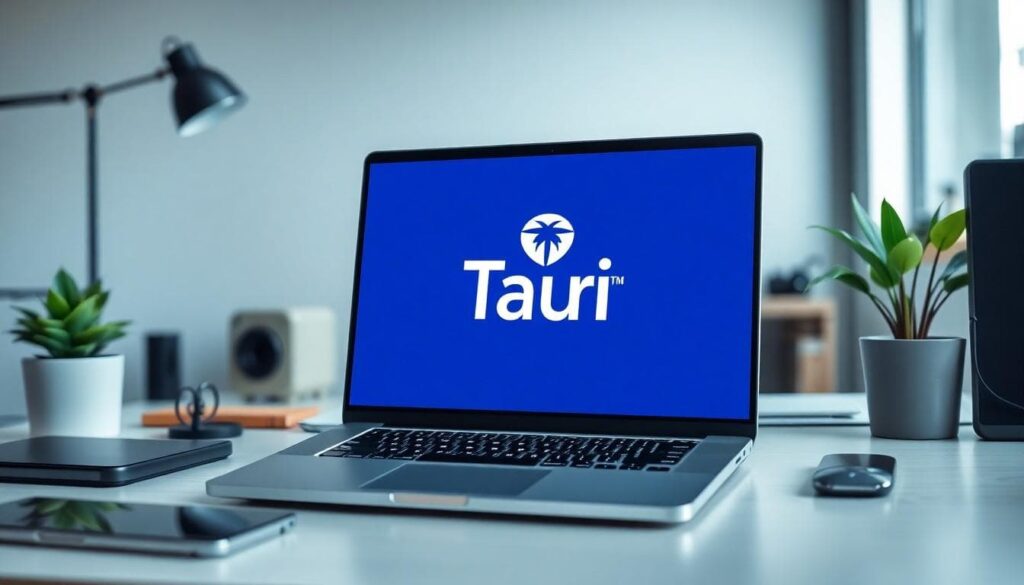Imagine firing up a desktop app that feels almost weightless—snappy, secure, and so small it barely leaves a trace on your hard drive. Now contrast that with the familiar hum of a memory-hungry giant, its features sprawling but resource demands just as hefty. In 2025, the crossroads between Tauri and Electron isn’t just about choosing a framework—it’s about deciding what kind of experience you want to deliver.
You’ll find yourself navigating a landscape where Tauri’s rapid adoption and featherlight performance challenge Electron’s long-standing dominance and vast community. The lines are drawn: do you reach for speed and efficiency, or lean into a mature ecosystem with all the bells and whistles? Let’s peel back the layers and see which path truly fits your next big idea.
Tauri VS. Electron – Real world application
Developers use Electron for software requiring advanced graphical features and a wide library selection. Apps like Discord and Visual Studio Code rely on Electron’s large JavaScript ecosystem and seamless Node.js integration to support plugins, themes, and real-time collaboration. Electron matches projects that accept higher memory consumption and larger file sizes in return for rapid development with familiar web tools.
Tauri supports tools where speed and size are priorities. Developers select Tauri for apps like payload transfer clients and database managers aiming for minimal RAM usage and compact binaries. For example, Tauri-powered apps can run with a file size as small as 2.5 MB and use about 30 MB of RAM. This efficiency makes Tauri a strong option for resource-constrained environments or systems where multiple processes run together.
Security stands out as a major difference. Tauri reduces attack surfaces using Rust, which gives stricter system access controls by default. Electron gives more system access through Node.js, which increases flexibility but also the potential for security risks if not handled with care.
Choosing between Tauri and Electron depends on your needs for features, performance, and ecosystem. If your project values a quick launch, smaller installs, and better memory efficiency, Tauri delivers clear gains. If you need an established development community, broad plug-in support, and don’t mind larger installations, Electron fits better.
Bonus Free Spins Advantage in Tauri Apps
Game applications built with Tauri often load faster due to small binaries, giving users more sessions and quicker access to bonus free spins. Developers who focus on user retention choose Tauri for instant rewards delivery, ensuring the player receives bonus free spins with little delay after app launch.
Bonus Free Spins Integration with Electron Features
Electron applications allow for complex graphics and interactive promotions, helping platforms design richer bonus free spins offers. The broad JavaScript toolset makes it easier to integrate third-party reward APIs and customize how bonus free spins appear in multi-feature games, enhancing user engagement with real-time prize notifications.
Electron app architecture

Electron app architecture uses JavaScript, HTML, and CSS to create desktop applications. Electron bundles a full Chromium browser engine and Node.js for system access. This structure guarantees that your app works the same on Windows, macOS, and Linux. Each Electron app contains its private Chromium runtime, increasing the app’s disk size and memory use. For example, development teams use React or Vue within Electron to build user interfaces efficiently. Node.js integration lets you use file systems, build scripts, or process data directly from your Electron app.
Electron’s architecture provides a wide range of APIs, allowing deep integration with the host OS. You can manage windows, read files, and trigger notifications without extra modules. This broad access supports complex features and background operations necessary for advanced apps. As seen in Discord and Visual Studio Code, this model lets developers use many third-party JavaScript libraries, increasing productivity and reducing time to launch.
In some applications, bonus free spins for games or rewards use Electron’s API integrations. You can embed interactive promotions by connecting your desktop app to web-based bonus spin engines. If you develop casino or gaming clients, Electron simplifies the process of fetching and displaying free spins, rewards, or promotional banners, making the experience seamless for both developers and users.
Bonus free spins in Electron-powered gaming apps benefit from rapid interface changes and API calls. Your app can pull bonus data or spin opportunities in real time, using JavaScript to create smooth, attractive notifications. The capacity to render graphics with Chromium ensures each bonus feels visually engaging, encouraging more user participation and sustained interest.
Tauri app architecture

Tauri creates desktop apps by using native system webviews and a backend built with Rust. You control the UI with standard web tools like HTML, CSS, and JavaScript. Tauri doesn’t bundle a browser engine; instead, it uses what the operating system provides—WebView2 for Windows, WebKit for macOS, and WebKitGTK for Linux. This reduces the file size significantly. For instance, Tauri apps often measure as small as 2.5–3 MB. You also see sharp reductions in RAM use, with most Tauri apps only consuming 30–40 MB, even for real-world utilities.
Tauri’s backend runs on Rust. This setup increases memory safety and speed by limiting system access through secure APIs. Tauri keeps core permissions off until you activate them. By default, your desktop apps expose fewer attack surfaces than those built with frameworks using Node.js. You can integrate your preferred tools, including frameworks like Svelte, Nuxt, or Vue, since Tauri’s frontend remains agnostic. This lets you work in your established workflow while gaining tighter control over app size and security.
Tauri’s architecture also works well with gaming applications seeking lightweight code and minimal resource use. In bonus free spins features for gaming platforms, Tauri can ensure quick startup times and lower wait periods for users. Your platform can serve free spin rewards rapidly, as Tauri keeps both the binary small and resource consumption low.
With Tauri, you also add value to promotions like bonus free spins by delivering crisp notifications and seamless UI updates. Users claim free spins instantly due to the fast interface and reduced memory footprint. Gaming companies use Tauri’s efficient resource management to maintain smooth bonus features and real-time data sharing, improving engagement for every promotional round.
Core Architecture Comparison
Electron uses JavaScript, HTML, and CSS for user interfaces. You work with a full Chromium browser engine bundled inside each app. The Node.js runtime gives system access and allows for running background tasks. Electron manages everything through a main process, which launches renderer processes for each window. This setup lets you develop apps that look and behave the same on Windows, macOS, and Linux.
Tauri builds desktop apps with web technologies, but you don’t get a bundled browser engine. Instead, Tauri relies on each operating system’s native webview—WebView2 for Windows, WebKit for macOS, and WebKitGTK for Linux. Rust powers the backend, processing logic and communication. System access comes through a limited set of secure APIs. You still link modern frontends like React, Vue, or Svelte, as Tauri stays frontend-agnostic.
Application size presents a key difference. Electron apps start at around 40 MB because they include Chromium. Tauri apps can be as small as 2.5–3 MB, thanks to native webviews and Rust’s efficiency. RAM usage also favors Tauri, often using 30–40 MB, while Electron apps use significantly more.
Security works differently. Electron exposes more of the system for flexibility through Node.js, but this increases exposure to potential attacks without careful sandboxing. Tauri, built with Rust, restricts backend access and narrows system exposure by default, reducing risks for most use cases.
Bonus free spins benefit from Tauri’s fast architecture. Games load quickly and handle real-time rewards without delay since Tauri’s binaries are small and memory usage stays low. This makes user actions like starting a bonus game immediate, which matters in short-session environments.
Bonus free spins also use Electron’s deep system integration for richer experiences. The advanced API access lets you build interactive notification systems that trigger special spin events. Even though higher resource use, Electron supports complex UI changes and synchronized multimedia content, enhancing engagement during bonus events.
Performance and Efficiency
Tauri delivers high efficiency. Its apps use native webviews, which keep binary sizes as small as 2.5–3 MB. RAM use stays low, ranging from 30–40 MB for typical applications. Startup times are fast, often under 500 ms. Rust powers Tauri’s backend, keeping system access limited and performance strong. This limits attack risks and maintains fast speeds for end users.
Electron apps are larger and use more resources. Each app includes a full Chromium engine, leading to baseline binaries starting at 40 MB. Memory use often exceeds 100 MB and can reach 300 MB for large projects. Startup times are slower, as apps load a browser environment before displaying content. Electron’s extensive API integration allows complex features, but this comes with higher CPU and RAM consumption.
| Framework | Binary Size | RAM Use | Startup Time |
| Tauri | 2.5–3 MB | 30–40 MB | ms |
| Electron | ≥40 MB | 100–300 MB | >500 ms |
Bonus free spins in desktop gaming apps work better with Tauri. The quick startup means players see bonus rounds without delays. Light RAM use keeps bonus free spin notifications crisp and instant. Gaming apps built using Tauri stream bonus rounds smoothly due to lower resource needs, making every bonus free spin feature feel more immediate.
With Electron, bonus free spin features can lag. Higher memory and slower startup push bonus round delivery times up. While Electron lets you build rich UIs for bonus free spin banners and pop-ups, results can suffer on lower-end systems due to the bigger memory footprint.
Tauri’s low memory use and fast startups help keep real-time notifications and user actions smooth. This is important for time-sensitive features like bonus free spins in both gaming and rewards apps. You get a better player experience, as less memory means more system resources for other tasks.
Electron lets you use more complex UI elements for bonus free spins. But, this comes with a trade-off in performance and speed. Larger package size and increased RAM use make Electron fit for powerful desktops, not resource-constrained devices. Choose Tauri to keep things light if you want bonus free spins to run fast and smooth for all users.
Security Considerations
Tauri uses Rust for its backend, restricting system access by default. This sharply limits possible entry points for attackers. Electron grants broad access through Node.js integration, which expands available features but raises risk by exposing more system-level APIs. Tauri’s narrow API surface protects applications from direct system manipulation while Electron’s flexible environment requires constant attention to permissions and updates.
Tauri apps have fewer vulnerabilities because they do not ship with a full browser engine. This reduces the risk of exploits tied to component updates or unpatched engines. In contrast, Electron bundles a full Chromium engine, making apps vulnerable to any flaws in Chromium or Node.js at the time of release. Security updates in Electron must address both the browser and backend dependencies, increasing maintenance needs.
Tauri disables unsafe operations by default. You only unlock more system features by deliberate configuration. This setup reduces user exposure to malware and unauthorized actions. Electron allows faster integration of third-party libraries and plugins but depends on effective sandboxing and audit practices to keep threats at bay.
Bonus free spins features benefit from Tauri’s approach. Applications can safely display notifications and process instant rewards for free spins without unwanted system access. If you need to handle bonus free spins in apps with private or payment-related data, Tauri’s lockdown keeps user data safer than Electron’s broader access model.
Gaming applications using bonus free spins also gain security from Tauri’s lower memory footprint. With fewer components running, there are less background vulnerabilities that attackers might exploit during quick gameplay sessions. This structure ensures bonus free spins features launch without lag and with a decreased chance of compromised processes.
Tauri’s design offers clear, simple defaults that help you avoid common pitfalls in desktop security. Electron provides powerful customization but asks you to weigh security against performance and access. Your choice impacts how reliably users can engage with bonus free spins and other interactive rewards, especially where personal or payment data matters.
Development Experience
Tauri uses Rust for its backend and supports frontend frameworks like React, Svelte, and Vue. You interact with native system webviews, so your UI looks consistent with the operating system. Tauri projects start at 2.5–3 MB, saving disk space on user devices. Electron relies on JavaScript, HTML, and CSS, so you can use existing web skills to build desktop applications. You get seamless integration with Node.js, letting you access a wide library ecosystem for tasks like real-time notifications or database management.
Electron offers fast prototyping because almost any web developer can contribute. You manage most resources with familiar JavaScript patterns, leading to a quick workflow. The mature Electron community helps you find solutions quickly by searching existing answers or using boilerplate templates. For updates, you don’t need to recompile the app, letting you iterate easily. Tauri development requires knowledge of Rust for the backend, which can slow onboarding if your team is new to the language. You edit configuration files for permissions and APIs, making Tauri precise in system exposure but requiring extra steps for advanced features.
You can add bonus free spins to your Electron app by integrating third-party libraries from the Node.js ecosystem. Many packages offer features like secure spin logic, animations, and real-time prize displays. These packages save development time, support custom branding, and produce smooth user experiences.
Tauri apps allow bonus free spins by exposing APIs to the frontend through secure Rust code. You limit access to system resources, so user data stays safe. Tauri’s quick startup speed helps you create fast-loading bonus spin features, benefiting gaming or promotional applications. Users enjoy minimal wait times, which increases engagement during active reward periods.
Use Cases and Suitability
Tauri and Electron both support desktop app development, but each suits different project needs. Your choice affects performance, security, and resource use.
Ideal Scenarios for Each Framework
Tauri fits lightweight apps. Examples include file transfer clients, database managers, and quick launch utilities. Tauri’s memory use ranges from 30–40 MB, with binaries as small as 2.5–3 MB. Tauri apps start fast, often under 500 ms. These facts make Tauri suitable for resource-constrained systems or users who want quick performance. Tauri uses Rust, which gives a security edge. Default system access is limited, so Tauri lowers attack risks.
Electron suits resource-rich, feature-heavy apps. Apps like Discord and Visual Studio Code use Electron for their graphical needs and plugin systems. Electron’s large library access through Node.js allows deep OS integration and advanced user interfaces. Its community is large, so finding support and libraries is easy. Electron powers about 60% of cross-platform desktop apps, as seen in 2024 Stack Overflow data. But, Electron apps are larger, starting around 40 MB, and use more memory.
Bonus Free Spins in Gaming Apps
Bonus free spins enhance engagement in desktop gaming apps. Both Tauri and Electron deliver these promotional features, but their performance differs. Tauri’s quick startup and low memory needs let users open and use bonus free spins features with minimal delay, keeping the gaming experience smooth. The small binary size helps load bonus rounds faster, so players see less waiting time.
Electron enables rich game interfaces for bonus free spins, thanks to its flexible web tools. Developers use JavaScript and CSS to integrate pop-ups, notifications, and animations linked to free spin promotions. Electron manages complex, interactive features for users but consumes more resources, which may slow loading if the device is busy.
Security in Bonus Free Spins Features
Tauri protects bonus free spins with stricter system access. The backend uses Rust, which blocks unsafe API calls by default. Users see fewer security risks when claiming free spin offers or handling in-game rewards. Sensitive operations occur through well-controlled APIs, reducing malware exposure.
Electron provides more freedom but increases potential attack points. Managing system permissions for bonus free spins or other interactive rewards requires careful updates. Developers must check third-party libraries and manage user data closely to keep the feature secure.
Project choice connects directly with user experience for bonus free spins. Tauri gives speed and safety, making it fit for games needing fast loads and security. Electron delivers advanced visuals and notifications, benefiting apps where engagement and features matter more than resource savings.
Conclusion
Choosing between Tauri and Electron in 2025 means weighing your project’s priorities. If you value speed, efficiency, and top-notch security, Tauri’s lightweight design and Rust backend give you a clear advantage. For those needing advanced features and a vast ecosystem, Electron’s mature platform and deep integration remain hard to beat.
Think about your team’s expertise, your application’s requirements, and how much you want to optimize for performance or flexibility. Both frameworks have evolved to meet modern demands, so your best choice comes down to what matters most for your users and your development goals.



